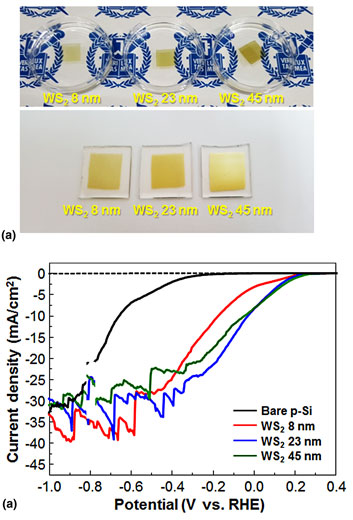Crossref Citations
This article has been cited by the following publications. This list is generated based on data provided by
Crossref.
Stoerzinger, Kelsey A.
Du, Yingge
Spurgeon, Steven R.
Wang, Le
Kepaptsoglou, Demie
Ramasse, Quentin M.
Crumlin, Ethan J.
and
Chambers, Scott A.
2018.
Chemical and electronic structure analysis of a SrTiO3 (001)/p-Ge (001) hydrogen evolution photocathode.
MRS Communications,
Vol. 8,
Issue. 2,
p.
446.
Li, Changli
Cao, Qi
Wang, Faze
Xiao, Yequan
Li, Yanbo
Delaunay, Jean-Jacques
and
Zhu, Hongwei
2018.
Engineering graphene and TMDs based van der Waals heterostructures for photovoltaic and photoelectrochemical solar energy conversion.
Chemical Society Reviews,
Vol. 47,
Issue. 13,
p.
4981.
Kim, Taemin Ludvic
Choi, Min-Ju
and
Jang, Ho Won
2018.
Boosting interfacial charge transfer for efficient water-splitting photoelectrodes: progress in bismuth vanadate photoanodes using various strategies.
MRS Communications,
Vol. 8,
Issue. 3,
p.
809.
Yang, Wooseok
Prabhakar, Rajiv Ramanujam
Tan, Jeiwan
Tilley, S. David
and
Moon, Jooho
2019.
Strategies for enhancing the photocurrent, photovoltage, and stability of photoelectrodes for photoelectrochemical water splitting.
Chemical Society Reviews,
Vol. 48,
Issue. 19,
p.
4979.
Hasani, Amirhossein
Van Le, Quyet
Tekalgne, Mahider
Choi, Min-Ju
Choi, Seokhoon
Lee, Tae Hyung
Kim, Hayeong
Ahn, Sang Hyun
Jang, Ho Won
and
Kim, Soo Young
2019.
Fabrication of a WS2/p-Si Heterostructure Photocathode Using Direct Hybrid Thermolysis.
ACS Applied Materials & Interfaces,
Vol. 11,
Issue. 33,
p.
29910.
Abbas, Omar Adnan
Sazio, Pier
Wang, He
Lewis, Adam Henry
Sessions, Neil
Aspiotis, Nikos
Huang, Chung-Che
Zeimpekis, Ioannis
Hewak, Dan
and
Mailis, Sakellaris
2019.
Growth of Large-Area, Uniform, Few-Layer Tungsten Disulphide by Thermal Decomposition of Ammonium Tetrathiotungstate.
p.
1.
Seo, Sehun
Kim, Seungkyu
Choi, Hojoong
Lee, Jongmin
Yoon, Hongji
Piao, Guangxia
Park, Jun‐Cheol
Jung, Yoonsung
Song, Jaesun
Jeong, Sang Yun
Park, Hyunwoong
and
Lee, Sanghan
2019.
Direct In Situ Growth of Centimeter‐Scale Multi‐Heterojunction MoS2/WS2/WSe2 Thin‐Film Catalyst for Photo‐Electrochemical Hydrogen Evolution.
Advanced Science,
Vol. 6,
Issue. 13,
Hasani, Amirhossein
Tekalgne, Mahider
Le, Quyet Van
Jang, Ho Won
and
Kim, Soo Young
2019.
Two-dimensional materials as catalysts for solar fuels: hydrogen evolution reaction and CO2 reduction.
Journal of Materials Chemistry A,
Vol. 7,
Issue. 2,
p.
430.
Suh, Jun Min
Shim, Young-Seok
Kwon, Ki Chang
Jeon, Jong-Myeong
Lee, Tae Hyung
Shokouhimehr, Mohammadreza
and
Jang, Ho Won
2019.
Pd- and Au-Decorated MoS2 Gas Sensors for Enhanced Selectivity.
Electronic Materials Letters,
Vol. 15,
Issue. 3,
p.
368.
Abbas, Omar A.
Zeimpekis, Ioannis
Wang, He
Lewis, Adam H.
Sessions, Neil P.
Ebert, Martin
Aspiotis, Nikolaos
Huang, Chung-Che
Hewak, Daniel
Mailis, Sakellaris
and
Sazio, Pier
2020.
Solution-Based Synthesis of Few-Layer WS2 Large Area Continuous Films for Electronic Applications.
Scientific Reports,
Vol. 10,
Issue. 1,
Nguyen, Van‐Huy
Nguyen, Thang P
Le, Thu‐Ha
Vo, Dai‐Viet N
Nguyen, Dang LT
Trinh, Quang Thang
Kim, Il Tae
and
Le, Quyet Van
2020.
Recent advances in two‐dimensional transition metal dichalcogenides as photoelectrocatalyst for hydrogen evolution reaction.
Journal of Chemical Technology & Biotechnology,
Vol. 95,
Issue. 10,
p.
2597.
Tekalgne, Mahider Asmare
Hasani, Amirhossein
Heo, Do Yeon
Van Le, Quyet
Nguyen, Thang Phan
Lee, Tae Hyung
Ahn, Sang Hyun
Jang, Ho Won
and
Kim, Soo Young
2020.
SnO2@WS2/p-Si Heterostructure Photocathode for Photoelectrochemical Hydrogen Production.
The Journal of Physical Chemistry C,
Vol. 124,
Issue. 1,
p.
647.
Lewis, Adam H.
De Lucia, Francesco
Belardi, Walter
Huang, Chung-Che
Hayes, John R.
Poletti, Francesco
Hewak, Dan
and
Sazio, Pier J. A.
2020.
Composite material anti-resonant optical fiber electromodulator with a 3.5 dB depth.
Optics Letters,
Vol. 45,
Issue. 5,
p.
1132.
Jun, Sang Eon
Hong, Seung‐Pyo
Choi, Seokhoon
Kim, Changyeon
Ji, Su Geun
Park, Ik Jae
Lee, Sol A
Yang, Jin Wook
Lee, Tae Hyung
Sohn, Woonbae
Kim, Jin Young
and
Jang, Ho Won
2021.
Boosting Unassisted Alkaline Solar Water Splitting Using Silicon Photocathode with TiO2 Nanorods Decorated by Edge‐Rich MoS2 Nanoplates.
Small,
Vol. 17,
Issue. 39,
Yoon, Ji‐Won
Kim, Jae‐Hyeok
Kim, Changyeon
Jang, Ho Won
and
Lee, Jong‐Heun
2021.
MOF‐Based Hybrids for Solar Fuel Production.
Advanced Energy Materials,
Vol. 11,
Issue. 27,
Jun, Sang Eon
Choi, Seokhoon
Choi, Shinyoung
Lee, Tae Hyung
Kim, Changyeon
Yang, Jin Wook
Choe, Woon-Oh
Im, In-Hyuk
Kim, Cheol-Joo
and
Jang, Ho Won
2021.
Direct Synthesis of Molybdenum Phosphide Nanorods on Silicon Using Graphene at the Heterointerface for Efficient Photoelectrochemical Water Reduction.
Nano-Micro Letters,
Vol. 13,
Issue. 1,
Hu, Shu
2022.
Springer Handbook of Inorganic Photochemistry.
p.
879.
Gupta, Bikesh
Tournet, Julie
Tan, Hark H.
Jagadish, Chennupati
and
Karuturi, Siva K.
2022.
Atomic and Nano Scale Materials for Advanced Energy Conversion.
p.
361.
Hwan Cho, Sung
Min Suh, Jun
Jeong, Beomgyun
Hyung Lee, Tae
Soon Choi, Kyoung
Hoon Eom, Tae
Kim, Taehoon
and
Won Jang, Ho
2022.
Fast responding and highly reversible gasochromic H2 sensor using Pd-decorated amorphous WO3 thin films.
Chemical Engineering Journal,
Vol. 446,
Issue. ,
p.
136862.
Nguyen, Thang P.
2022.
Miniaturized Analytical Devices.
p.
153.






